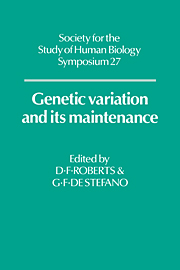Book contents
- Frontmatter
- Contents
- Preface
- Part I Genetic Diversity - Its Dimensions
- Part II Genetic Diversity - Its Origin and Maintenance
- GENETIC DIVERSITY - APPLICATIONS AND PROBLEMS OF COMPLEX CHARACTERS
- Significance of dermatoglyphics in studies of population genetic variation in man
- Polymorphisms of red-green vision among populations of the tropics
- Reductions in body size and the preservation of genetic variability in tropical populations
- Genetic isolates and the search for causal mechanisms of disease
- Index
Significance of dermatoglyphics in studies of population genetic variation in man
Published online by Cambridge University Press: 05 March 2012
- Frontmatter
- Contents
- Preface
- Part I Genetic Diversity - Its Dimensions
- Part II Genetic Diversity - Its Origin and Maintenance
- GENETIC DIVERSITY - APPLICATIONS AND PROBLEMS OF COMPLEX CHARACTERS
- Significance of dermatoglyphics in studies of population genetic variation in man
- Polymorphisms of red-green vision among populations of the tropics
- Reductions in body size and the preservation of genetic variability in tropical populations
- Genetic isolates and the search for causal mechanisms of disease
- Index
Summary
INTRODUCTION
Of all human morphological traits, dermatoglyphics are practically unique in their stability in the face of changes in age and environment. Established in the third month of prenatal life, the intricate patterns of ridges on the fingers and toes remain constant (apart from growth in size) until death in old age, and only vary if there is severe trauma to the digit. The quantitative total ridge count is regarded as the most highly heritable of all human continuously varying characters, shown by comparison of the observed correlation coefficients between relatives of different degrees and those expected on a multifactorial hypothesis in which genetic determination is complete. This conclusion derives from the early work of Holt (1952, 1961, 1968) on families in Britain, but has recently also been demonstrated in tropical populations by Hreczko and Ray (1985). The modes of inheritance of individual pattern types, minutiae and other detailed features are still not fully established, but the numerous studies of twins, family members, and patients with chromosomal disorders show how strong is the genetic influence upon these.
There remains much to be done in mapping the distribution of dermatoglyphic features in tropical populations, though the map is far fuller today than it was twenty years ago. In digital features there appear to be frequency clines sweeping across the tropical areas, there appear to be differences between the major population groups inhabiting the tropics, and there appear to be quantum differences between small tropical populations ethnically different from their neighbours, as for example the differences between the Bushmen of the Kalahari or the pygmies of the Ituri Forest who are quite distinct from their later-coming Bantu neighbours (Hauser, 1977).
- Type
- Chapter
- Information
- Genetic Variation and its Maintenance , pp. 237 - 244Publisher: Cambridge University PressPrint publication year: 1986
- 3
- Cited by



